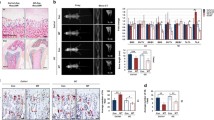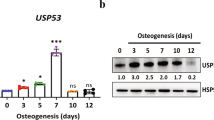Abstract
Survivin, the smallest member of the inhibitor of apoptosis gene family, is critical for the regulation of mitosis and maintenance of cell viability during embryonic development and cancer, while not being detectable in most adult differentiated tissues. We know little about whether survivin plays any physiological or pathophysiological role in the adult musculoskeletal system. We studied the expression of survivin in primary human osteoblastic cells and its biological functions in vitro. Survivin was detected by immunoblotting and real-time PCR. Subcellular localization was analyzed by immunofluorescence. Transfection of siRNA and plasmids coding for wild-type survivin was performed to study survivin function, i.e., proliferation and apoptosis assays. Survivin mRNA and protein are expressed in primary human osteoblastic cells. During interphase survivin localizes predominantly to the cytoplasmic compartment, which is relevant for the organization of the spindle apparatus during mitosis. Survivin knockdown resulted in an arrest of the cell cycle at the G2/M phase and increased rates of apoptosis. Elevated levels of survivin in primary human osteoblasts enhanced proliferation and cell viability. Taken together, we demonstrate for the first time that survivin is expressed in primary human osteoblastic cells on the mRNA and protein levels. Our results indicate that survivin is a critical factor for cell division and cell viability in primary human osteoblastic cells. Learning more about survivin’s role in human osteoblasts could be an important step toward understanding the complex processes involved in bone homeostasis and remodeling.





Similar content being viewed by others
References
Boyce BF, Xing L, Jilka RJ et al (2002) Apoptosis in bone cells. In: Bilezikian JP, Raisz LG, Rodan GA (eds) Principles of bone biology, 2nd edn. Academic Press, London, pp 151–168
Raaijmakers MH, Mukherjee S, Guo S et al (2010) Bone progenitor dysfunction induces myelodysplasia and secondary leukaemia. Nature 464:852–857
Mansukhani A, Bellosta P, Sahni M, Basilico C (2000) Signaling by fibroblast growth factors (FGF) and fibroblast growth factor receptor 2 (FGFR2)-activating mutations blocks mineralization and induces apoptosis in osteoblasts. J Cell Biol 149:1297–1308
Adida C, Crotty PL, McGrath J et al (1998) Developmentally regulated expression of the novel cancer anti-apoptosis gene survivin in human and mouse differentiation. Am J Pathol 152:43–49
Uren AG, Wong L, Pakusch M et al (2000) Survivin and the inner centromere protein INCENP show similar cell-cycle localization and gene knockout phenotype. Curr Biol 10:1319–1328
Altieri DC (2003) Validating survivin as a cancer therapeutic target. Nat Rev Cancer 3:46–54
Velculescu VE, Madden SL, Zhang L et al (1999) Analysis of human transcriptomes. Nat Genet 23:387–388
Li F, Brattain MG (2006) Role of the survivin gene in pathophysiology. Am J Pathol 169:1–11
Fukuda S, Pelus LM (2006) Survivin, a cancer target with an emerging role in normal adult tissues. Mol Cancer Ther 5:1087–1098
Lechler P, Wu X, Bernhardt W et al (2007) The tumor gene survivin is highly expressed in adult renal tubular cells: implications for a pathophysiological role in the kidney. Am J Pathol 171:1483–1498
Altieri DC (2008) Survivin, cancer networks and pathway-directed drug discovery. Nat Rev Cancer 8:61–70
Altieri DC (2006) The case for survivin as a regulator of microtubule dynamics and cell-death decisions. Curr Opin Cell Biol 18:609–615
Li F, Ackermann EJ, Bennett CF et al (1999) Pleiotropic cell-division defects and apoptosis induced by interference with survivin function. Nat Cell Biol 1:461–466
Dohi T, Beltrami E, Wall NR et al (2004) Mitochondrial survivin inhibits apoptosis and promotes tumorigenesis. J Clin Invest 114:1117–1127
Colnaghi R, Connell CM, Barrett RM, Wheatley SP (2006) Separating the anti-apoptotic and mitotic roles of survivin. J Biol Chem 281:33450–33456
Knauer SK, Kramer OH, Knosel T et al (2007) Nuclear export is essential for the tumor-promoting activity of survivin. FASEB J 21:207–216
Knauer SK, Bier C, Habtemichael N, Stauber RH (2006) The survivin-Crm1 interaction is essential for chromosomal passenger complex localization and function. EMBO Rep 7:1259–1265
Maurin AC, Chavassieux PM, Meunier PJ (2005) Expression of PPARc and b/d in human primary osteoblastic cells: influence of polyunsaturated fatty acids. Calcif Tissue Int 76:385–392
Jilka RL, Weinstein RS, Bellido T, Parfitt AM, Manolagas SC (1998) Osteoblasts programmed cell death (apoptosis): modulation by growth factors and cytokines. J Bone Miner Res 13:793–802
Ling X, Bernacki RJ, Brattain MG, Li F (2004) Induction of survivin expression by Taxol (paclitaxel) is an early event, which is independent of Taxol-mediated G2/M arrest. J Biol Chem 279(15):15196–15203
Kobayashi K, Hatano M, Otaki M, Ogasawara T, Tokuhisa T (1999) Expression of a murine homologue of the inhibitor of apoptosis protein is related to cell proliferation. Proc Natl Acad Sci USA 96:1457–1462
Johnson EA, Svetlov SI, Pike BR et al (2004) Cell-specific upregulation of survivin after experimental traumatic brain injury in rats. J Neurotrauma 21:1183–1195
Deguchi M, Shiraki K, Inoue H et al (2002) Expression of survivin during liver regeneration. Biochem Biophys Res Commun 297:59–64
Chiou SK, Tanigawa T, Akahoshi T et al (2005) Survivin: a novel target for indomethacin-induced gastric injury. Gastroenterology 128:63–73
Fortugno P, Beltrami E, Plescia J et al (2003) Regulation of survivin function by Hsp90. Proc Natl Acad Sci USA 100:13791–13796
Bidmon B, Endemann M, Muller T et al (2002) HSP-25 and HSP-90 stabilize Na, K-ATPase in cytoskeletal fractions of ischemic rat renal cortex. Kidney Int 62:1620–1627
Romanello M, Bivi N, Pines A et al (2006) Bisphosphonates activate nucleotide receptors signaling and induce the expression of Hsp90 in osteoblast-like cell lines. Bone 39:739–753
Powers MV, Clarke PA, Workman P (2009) Death by chaperone: HSP90, HSP70 or both? Cell Cycle 8:518–526
Gronowicz GA, McCarthy MB, Zhang H et al (2004) Insulin-like growth factor II induces apoptosis in osteoblasts. Bone 35:621–628
Weinstein RS, Jilka RL, Parfitt AM, Manolagas SC (1998) Inhibition of osteoblastogenesis and promotion of apoptosis of osteoblasts and osteocytes by glucocorticoids: potential mechanisms of their deleterious effects on bone. J Clin Invest 102:274–282
Kitajima I, Nakajima T, Imamura T et al (1996) Induction of apoptosis in murine clonal osteoblasts expressed by human T-cell leukeumiavirus type I tax by NF-kappa B and TNF-α. J Bone Miner Res 11:200–210
Tsuboi M, Kawakami A, Nakashima T et al (1999) Tumor necrosis factor-alpha and interleukin-1beta increase the Fas-mediated apoptosis of human osteoblasts. J Lab Clin Med 134:222–231
Chen J, Wu W, Tahir SK et al (2000) Down-regulation of survivin by antisense oligonucleotides increases apoptosis, inhibits cytokinesis and anchorage-independent growth. Neoplasia 2:235–241
Acknowledgements
We thank Anja Sabo and Luise Rauch for excellent technical assistance, Dr. Silvia Capellino helped kindly with the fluorescence microscope, and we are grateful to R. Stauber for the kind gift of the human cDNA for survivin. P. L. was supported by the Regensburger Forschungsförderung in der Medizin (ReForM).
Conflict of interest
The authors have stated that they have no conflict of interest.
Author information
Authors and Affiliations
Corresponding author
Rights and permissions
About this article
Cite this article
Lechler, P., Schaumburger, J., Köck, F.X. et al. The Oncofetal Gene Survivin Promotes Cell Proliferation and Survival in Primary Human Osteoblastic Cells. Calcif Tissue Int 89, 211–220 (2011). https://doi.org/10.1007/s00223-011-9508-y
Received:
Accepted:
Published:
Issue Date:
DOI: https://doi.org/10.1007/s00223-011-9508-y




